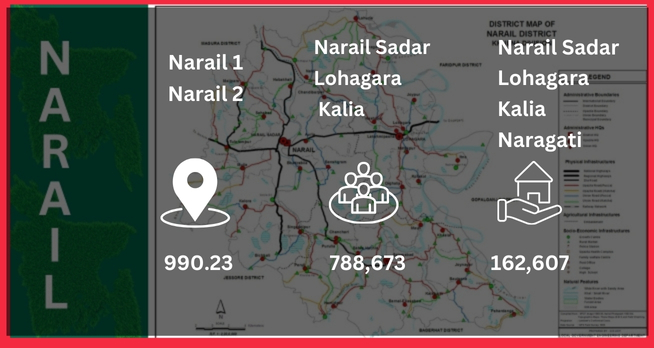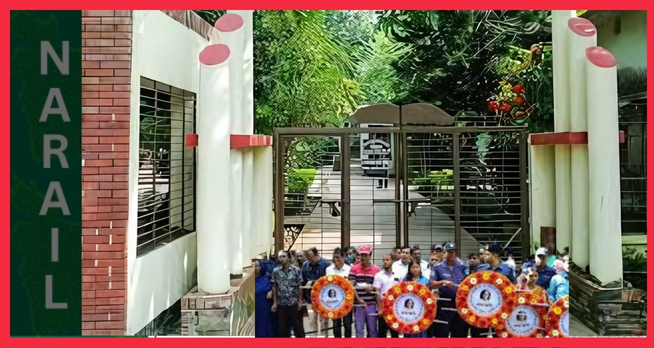Narail District Overview

Introduction
Narail is a historical and famous District in Khulna Division. Narail district is situated to the south of Magura District and to the north of Khulna District. The district is bordered by Faridpur and Gopalganj districts to the east and Jessore District to the west.
Geography and Area:
Narail District covers an area of 990.23 square kilometres, showcasing its blend of urban and rural environments. The region is divided into two electoral constituencies, Narail-1 and Narail-2, providing representation in the national parliament.
Population and Households:
Narail is home to a population of 788,673 people, with a nearly equal distribution between males (386,292) and females (402,381). The district has 162,607 households, and the population density stands at 796 people per square kilometre.
Administrative Divisions:

The district is divided into 3 upazilas (sub-districts) and 4 police stations (thanas). It also includes 3 municipalities (pourashavas) that are further subdivided into 27 wards. At the grassroots level, Narail has 39 unions and 635 villages, making it an agriculturally vibrant district with a strong community presence.
Rivers and Water Bodies:
Narail boasts five significant rivers: Nabaganga, Madhumati, Chitra, Kajla, and Afra, covering a riverine area of 29.32 square kilometers. These rivers contribute to the district’s agricultural and fishing industries.
Land and Agriculture:
The district has 36,279 acres of uncultivated land and 106,150 acres of cultivated land, making agriculture a backbone of its economy. The district’s operational land accounts for 234,337 acres, and the number of agricultural households totals 47,722. Various crops such as hybrid boro, aus, and aman rice, wheat, and jute are cultivated on thousands of acres.
Infrastructure:
Narail features a robust road network, including 440 kilometers of paved roads. It also has 54 markets, 11 ferry ghats, and numerous agricultural facilities such as deep tube wells, shallow tube wells, power pumps, and tractors. The district’s connectivity and transport options make it accessible for both locals and visitors.
Education and Literacy:
Narail has a literacy rate of 61.3%. The district is served by 3 government colleges, 2 government secondary schools, 123 private secondary schools, 286 government primary schools, and 42 private madrasas. Additionally, there is a government technical school and college to promote vocational education.
Healthcare Facilities:
The district provides healthcare through 1 district hospital with 100 beds, 3 Upazila health complexes, 7 sub-health canters, 32 union health and family welfare canters, and 68 community clinics. There are also 2 ambulances available for emergency services.
Tourist Attractions:
Narail offers several tourist spots, including the Sultan Complex, Birshrestha Nur Mohammad Complex, and the picturesque Chitra Resort. The district is also known for its historical landmarks like the Haatbari Zamindar House and the Brammomoyi Math Temple. Additionally, Arunima Eco Park in Kalia upazila is a popular destination for nature lovers.
Cultural Significance:
he district hosts the annual Sultan Mela in memory of the world-renowned artist S.M. Sultan. This festival is a significant cultural event that draws visitors from across the country.
Narail District is proud to be the birthplace of several prominent personalities who have made remarkable contributions to Bangladesh’s cultural, social, and sports arenas. Among the most celebrated figures from this region are:
SM Sultan (1923–1994)
World-renowned painter and visionary artist, SM Sultan, is one of the most revered cultural icons from Narail. Known for his unique portrayal of rural life and human figures, Sultan’s artwork has earned international acclaim. His contributions to art are celebrated annually through the Sultan Mela, a cultural festival that draws artists and art enthusiasts from all over the country

Birsrestha Nur Mohammad Sheikh (1936–1971)
Nur Mohammad Sheikh, one of the seven recipients of the highest military honor in Bangladesh, the “Bir Sreshtho,” was a brave soldier from Narail. He fought valiantly during the Liberation War of 1971 and sacrificed his life in the battle against the Pakistani Army. His legacy of heroism continues to inspire the people of Narail and the entire nation.
Mashrafe Bin Mortaza (1983–Present)
A modern-day sports icon, Mashrafe Bin Mortaza, affectionately known as the “Narail Express,” is one of the most successful cricket captains in the history of Bangladesh cricket. His leadership on and off the field has earned him widespread respect. Mashrafe has also made a mark in the political sphere, representing Narail as a Member of Parliament, further demonstrating his commitment to the development of his home district.
Indigenous Communities:
Narail is home to indigenous groups like the Sardar and Rajbongshi communities, enriching its cultural and social fabric.
Natural Hazards:
Some areas of Narail, particularly Mahajan Bazar, Chandarchar, and Noagram in Kalia Upazila, as well as Mongolhata and Korfa in Lohagara Upazila, are prone to river erosion along the Madhumati River.
Conclusion
Narail District stands out for its rich cultural heritage, agricultural prominence, and strong community-oriented lifestyle. With its natural beauty, educational institutions, and healthcare facilities, it plays a crucial role in the socio-economic landscape of Bangladesh.




